CAT (Common Admission Test) exam is a computer-based admission test (but not an online exam) conducted for admission to various management programs of IIMs, including Post Graduate Programs (PGP) in Management, Fellow Programs in Management (FPM/ PhD) etc.
Let us first dive into the various aspects of the CAT exam (exam pattern, syllabus and eligibility), then we shall have a look at the 13 most important MBA exams in India.
In the latter part of this post, we shall discuss certain interesting strategic points about you as an MBA candidate (things like competencies, industry knowledge and communication skills) before we wrap up
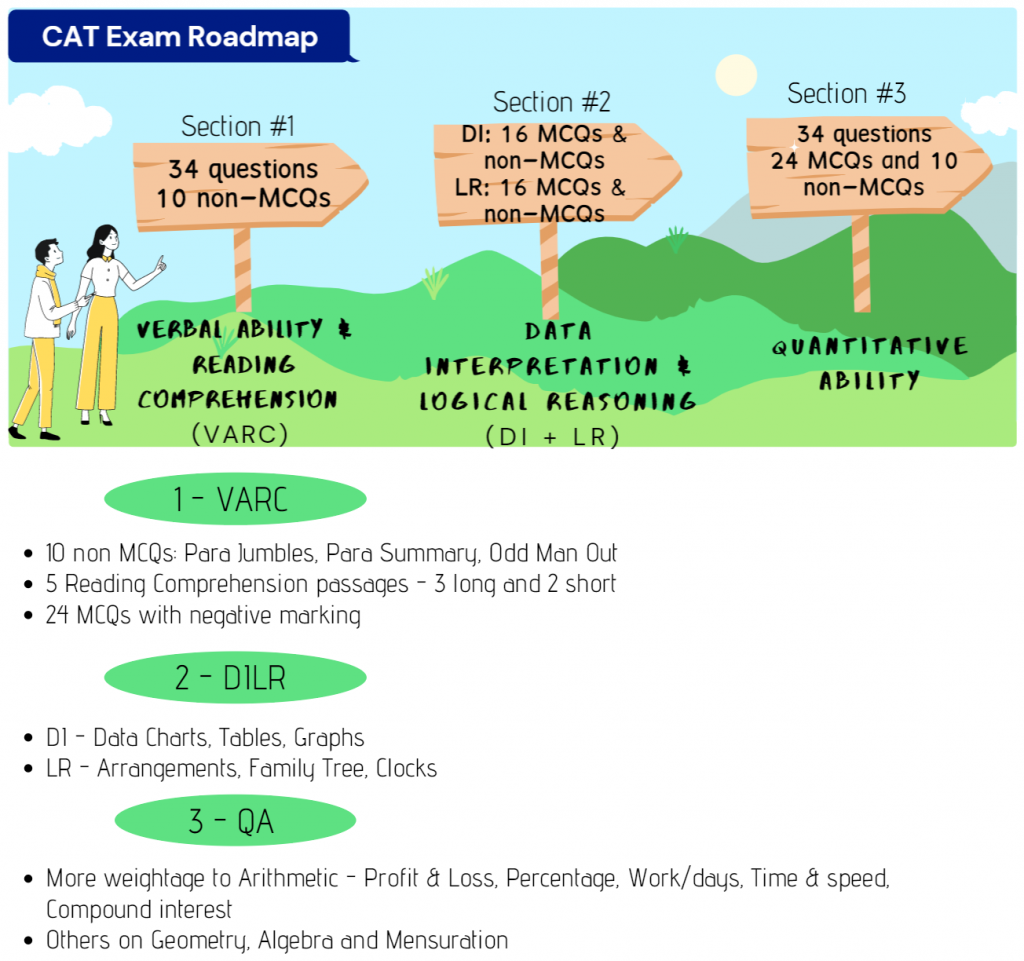
Topics covered
About CAT – In Brief
Before we dive into the detailed descriptions, we’ll quickly run through the highlights of the eligibility criteria and the exam pattern briefly.
There are 3 sections of CAT exam in this exact order:
- Verbal Ability & Reading Comprehension (VARC) – 1st Section
- Data Interpretation & Logical Reasoning (DILR) – 2nd Section
- Quantitative Ability (QA) – 3rd Section
Eligibility Criteria
You must hold a Bachelor level Degree, with at least 50% marks or equivalent CGPA (45% in case of SC, ST and Persons with Disability (PWD)).
In order to convert your CGPA to equivalent marks (if a scheme for such conversion does not exist according to your university), your CGPA will be divided by the maximum possible CGPA and the quotient will be multiplied with 100.
General Exam Pattern of CAT Exam
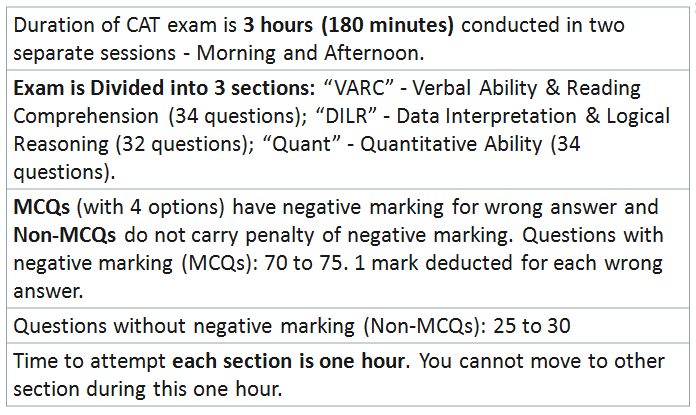
CAT Exam Pattern – Detailed
CAT exam pattern of 2020 remains similar to the existing pattern. You will not face any change in the testing mode this year.
Yes, IIM Indore is conducting CAT 2020 exam. They have clarified that there will be no change the CAT exam pattern in 2020 with respect to the number of questions or time duration.
CAT exam is held in a single day in 2 slots (morning and afternoon slots)
Depending on the status of the COVID-19 pandemic, the CAT exam this year is expected on Sunday, November 29, 2020. It is scheduled to be held in over 155 cities across the country.
Number of applicants for CAT exam had gone up to 2.44 lakhs in 2019. This year would be close, as expected.
Highlights of CAT Exam
CAT is conducted as a computer based test.
The exam has 100 questions divided into 3 sections – VARC, DILR and Quant.
Each section is timed to a limit of 1 hour. There is a sectional score cut off in IIMs for shortlisting. It will be a computer-based test of 3 hours duration.
16 Key Facts of The CAT Exam Pattern
- CAT is a computer based exam, but not online exam.
- Duration is 3 hours (180 minutes)
- CAT exam is conducted in 2 separate slots or sessions-Morning and Afternoon
- 100 Questions are divided into both MCQs and Non-MCQ type questions
- CAT Exam has 3 sections: VARC (34 questions); DILR (32 questions); Quant (34 questions)
- MCQs have negative marking
- Non-MCQs do not have negative marking
- There are 70 to 75 questions MCQs (questions with negative marking)
- 4 answer options for MCQ type questions
- There are 25 to 30 Non-MCQs (questions without negative marking)
- You must type in your answer in the given space on your computer terminal for Non-MCQ type questions.
- Each correct answer is awarded 3 marks
- Wrong answers carry ‘-1’ mark
- Fixed order of sections: VARC -> DILR -> Quant
- You cannot move to the next section during the one hour allotted for a section
- IIMs are expected to release question pattern on the CAT exam website around Oct 16-17, 2020
Detailed CAT Sectional Composition
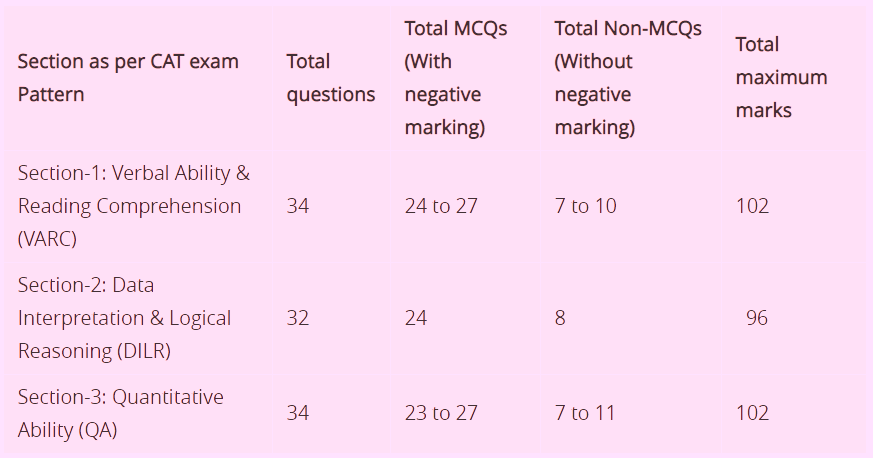
Is CAT exam an online test?
No. CAT exam is a digital computer-based test but you will not take the exam on an internet site.
Instead of reading the questions in a paper booklet and darkening the ovals on the answer-sheet, you will have to read the questions on your computer screen and choose an answer by clicking on the correct option which will also arrive on your computer screen. Additionally, the timer on the computer screen will tell you the time you have remaining to complete the current section.
CAT exam 2020: Section Wise Exam Pattern
Verbal Ability & Reading Comprehension (VARC) – 1st Section
Section highlights:
- No Grammar or vocabulary based questions
- Verbal Ability confined to 3 topics
- Jumbled paragraph
- Para summary
- Picking the odd sentence out of jumbled ones
- 2 subsections: Reading comprehension and Verbal Ability
| Total questions | 34 |
| MCQs | 24 to 27 |
| Non-MCQs | 7 to 10 |
| Reading Comprehension (RC) Passages | 5 |
| RC based Subsection Questions (MCQs) | 24 |
| Verbal Ability (DI) Subsection Questions (MCQ + non-MCQ) | 10 |
Data Interpretation & Logical Reasoning (DILR) – 2nd Section
Section highlights:
- You will have the questions in sets of 4
- Questions are more time consuming; you may face a crunch situation with respect to allotted time for this section.
- 2 subsections: Data Interpretation and Logical Reasoning
| Total questions | 32 |
| MCQs | 24 |
| Non-MCQs | 8 |
| Data Interpretation (DI) Subsection Questions | 16 |
| Logical Reasoning (LR) Subsection Questions | 16 |
Quantitative Ability (QA) – 3rd Section
Section highlights:
- You must expect maximum weightage for Arithmetic questions – Profit & Loss, Percentage, Work/days, Time & speed, Compound interest
| Total questions | 34 |
| MCQs | 23 to 27 |
| Non-MCQs | 7 to 11 |
CAT exam syllabus
IIMs release an official mock test instead of a specific CAT syllabus. This mock test is based exactly on subsequent CAT exam and comprises question types which you must expect in actual CAT Exam.
You must attempt the mock test to understand and internalize the pattern of examination and types of questions.
CAT exam Syllabus has changed since 2015. The syllabus is not specifically defined although it is very vast with broad topics covered.
However, over the years, CAT exam syllabus has covered subjects, chapters and topics pertaining to Reading Comprehension, Verbal Ability, Data Interpretation, Logical Reasoning, Quantitative Ability and is now divided into 3 sections. CAT exam requires a smart preparation keeping in mind the syllabus topics.
How is the CAT Syllabus Prepared & Updated?
IIMs release an official mock test instead of a specific CAT syllabus. This mock test is based exactly on subsequent CAT exam and comprises question types which you must expect in actual CAT Exam.
Experts at iDC present here the curated CAT exam syllabus based on different types of questions as you would expect in the CAT Exam.
CAT Exam Syllabus: Highlights
| The Syllabus is divided in 3 sections viz. Verbal Ability & Reading Comprehension (VARC), Data Interpretation & Logical Reasoning (DILR), and Quantitative Ability |
| You will have both MCQs and Non-MCQs in each of the 3 sections |
| The effective number of sections are 5 as VARC and DILR sections are further subdivided into 2 sub-sections each |
| A full length CAT mock exam based on current CAT exam syllabus, with 100 questions of 3 hours duration will be released in October by the IIMs |
CAT Exam Syllabus: Sectional Composition
| Section | Total no. of Questions | Key Topics |
| Section-1: Verbal Ability & Reading Comprehension (VARC) | 34 | 5 Passages (RC)24 questions Inferences, statements, arguments, main idea, author’s assumption, vocabularySynonyms, antonyms, meaning of the phrase as given in the passage10 questions (VA)Para SummaryJumbled paragraphs with 4 sentencesJumbled paragraphs with 5 sentences Pick the odd sentence out |
| Section-2: Data Interpretation& Logical Reasoning (DILR) | 32 | You shall expect questions in sets of 4-5 both in DI and LR. 16 questions in DI – Data comparison from Table, Data Analysis, Graphs, Pie charts, Bar charts, Caselets. 16 questions in LR – Direction sense, Seating Arrangement, Team formation, Blood Relation among others |
| Section-3: Quantitative Ability (QA) | 34 | You shall expect 50% questions on Arithmetic – Ratio, Interest, Percentage, Number System, Speed & Distance, Profit & Loss, Time & Work and others. Rest 50% will be Geometry, Algebra, Mensuration, Modern Math |
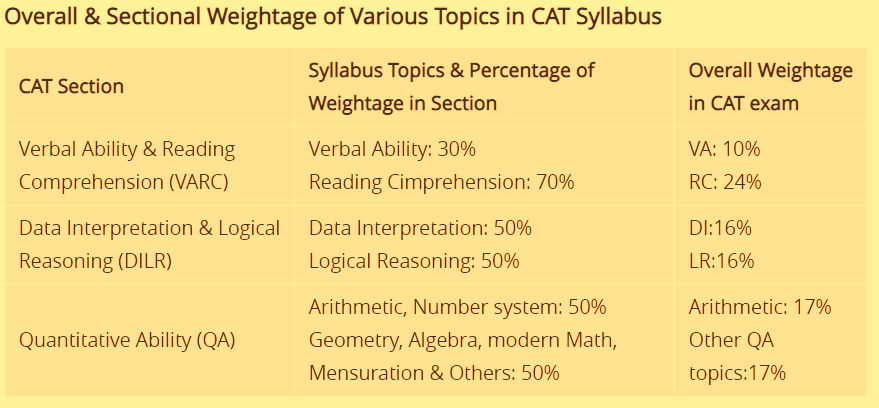
Detailed CAT Exam Syllabus
As per what has been observed in past academic years, shorter passages are of around 600 words and longer passages are of around 900 words.
- Current affairs – International Affairs, Social Life, Govt policies and Schemes for example Triple Talaq, Covid 19 Pandemic, Clean India Mission, CAA, migration of people across countries, Growing intolerance across the Globe
- Business & Economics – Global economic changes, Impact of Demonetization in India, economic development at the cost of environment, Wasteful expenditure by Governments
- Various English Literature books – thinkers, great philosophers, speeches of great personalities, important personalities like M K Gandhi, Aristotle, Charles Dickens, Martin Luther King, Churchill
- Passages on science & culture and advancement of technology
- Abstract topics and fiction
- Historical events & social changes – War of Roses, French Revolution, etc.
- Mythology – try to correlate with current social structure
Format of Questions
- Questions in this subsection will hover around these points:
- Based on information in RC passage
- Explanation of the words & phrases used in the passage
- True/false statement
- Author’s view on various issues raised in the passage
- Inference from the passage
- Main idea of the passage
- Purpose of the passage
Past trends of topics
- Second World War
- Genetics
- Plastic Pollution
- Consumer Behaviour
- Elephant society
- Sustainable Economic Development
- Education System
- Status of Languages in 2115
- Govt. Definition of Poverty
- Anthropology /Excruciating Rituals & Reasons
- Treatment of Household work
CAT Exam Syllabus: Section 1 Sub-section 2 – Verbal Ability
All non-MCQ type questions with no negative marking for the wrong answer.
- 3-4 questions: Essence of short paragraph/Para summary
- 3-4 questions: Jumbled Paragraphs
- 2-3 questions: Out of Context Sentence in Jumbled paras
- Error Correction – Verb, Pronoun, Adjective, Noun, Adverb etc.
- Correcting sequence of sentences – reported speech, time clauses, correct use of conditional sentence, passive writing
- Vocabulary usage
- Finding correct synonyms and antonyms
- Fill in the blanks
- Analogies
- Completion of last sentence paras
- Sentence Completion
- Critical Reasoning
- Irrelevant Statements
- Facts, Inference and Judgment
- Phrasal Verbs Usage
CAT Exam Syllabus: Section 2 Sub-section 1- Data Interpretation (DI)
- Questions will be based on tables, text, charts (column, bar, pie), graphs (line, area), Venn diagrams, etc.
- Data can be given to you in the form of charts, tables, or graphs.
- Your ability to interpret the given data and answer questions based on it will be tested in this section.
- Data charts
- Data Tables
- Bar diagrams & Charts including Stacked, Simple, Composite Bar charts
- Graphs – Line X-Y Graphs
- Pie charts
- Caselet based Data
- Data analysis and Data comparison among others
Past trends of topics
- Table like Student Pass % over 5 years
- Table on Consumption of plant based & animal based protein
- Films, Completion, Launch, Release & Profits
- Kids learning in rural areas
- Happiness Index tables
- Flight operation questions
CAT Exam Syllabus: Section 2 Sub-section 2 – Logical Reasoning (LR)
- Clocks
- Binary logic
- Calendars
- Blood Relations (Family Tree)
- Seating Arrangement
- Assumption
- Logical Sequence
- Conclusion
- Premise
- Team Formation
- Linear and matrix arrangement
- Input-Output
- Direction sense and Decision Making
- Syllogism
- Series
- Rows
- Critical Reasoning
- Cubes
- Quantitative Reasoning
- Set Theory, Venn Diagrams, Network Diagrams
- Logical Reasoning based on Rankings
- Puzzles
Past trends of topics
- Distribution/Arrangement
- Arrangement of files in folders
- Students using various trains and their varying fares
- Burgers/Fries/ Ice Cream
- Venn Diagrams
- Direction sense – Cars
- Ordering items
- Seating Arrangement
CAT Exam Syllabus: Quantitative Ability
The syllabus for this section is very broad. This will be your 3rd and last section.
The syllabus covers almost everything in Mathematics that you may or may not expect.
Questions are based on different topics including Arithmetic, Mensuration, Modern Math, Algebra, Geometry, Trigonometry etc.
More number of questions for Arithmetic, usually around 10 to 12
- Percentages
- LCM and HCF
- Interest (Simple and Compound)
- Profit and Loss
- Number System (3-4) questions
- Speed, Time and Distance; Time and Work; Averages; Ratio and Proportion and others
- Geometry/Mensuration (6-8 questions)
- Algebra (5-7 questions)
- Venn diagrams
- Pure Math (1-2 questions)
- Complex Numbers
- Linear Equations; Quadratic Equations
- Binomial Theorem
- Logarithm; Progressions
- Inequalities
- Trigonometry
- Surds and Indices
- Probability Functions
- Permutation and Combination
- Mixtures and Alligations
- Set Theory
- Co-ordinate Geometry
Detailed Eligibility for CAT exam
Eligibility for CAT exam: General & OBC Candidates
- You must hold a Bachelor’s Degree – at least 50% marks or equivalent CGPA.
- 50% marks – If you have completed a professional degree (CA/CS/ICWA)
Eligibility for CAT exam: SC/ST/PwD Candidates
You must satisfy one of the following:
- 45% marks in graduation for SC, ST and Differently Abled (DA) category
- If you are in final year of graduation, you will be eligible to apply
- 45% marks – If you have completed a professional degree (CA/CS/ICWA)
Eligibility for CAT exam: Final Year Students
This is as under:
- General/OBC/EWS: If you are in the final year of Graduation, you will be eligible to apply. You should score minimum 50% marks when your result is declared
- SC/ST/PwD Candidates: If you are in the final year of Graduation, you will be eligible to apply. You should score a minimum of 45% marks when your result is declared
- If selected, you will be allowed to join the program provisionally. You will have to submit your pass certificate latest by June 30, 2021, stating that you have completed all the requirements for obtaining the bachelor’s degree on the date of the issue of the certificate
Eligibility for CAT exam: Age
There is no age bar for any category of candidates.
Key Points to ensure your eligibility
- CAT authorities do not impose any age bar to appear in the exam.
- You are eligible with a 2 years graduation (old system) provided your degree is UGC recognized
- One of these 3 main points must be fulfilled-
- A. You must have completed a Bachelor’s degree, or
- B. You must have completed a professional degree (CA/CS/ICWA), or
- C. You should be in the final year of your graduation
- The conversion of grades / CGPA to percentage of marks would be based on the procedure as certified by your University/ institution
- In case there is no such scheme defined by your university for converting CGPA into equivalent marks, your CGPA will be divided by the maximum possible CGPA, and the result will be multiplied with 100
- Mere fulfillment of eligibility criteria will not ensure your short listing by IIMs.
- You must declare and maintain a valid unique email account and a phone number throughout the selection process
Also Read: CAT Exam Syllabus & Pattern
7 Things You Must Remember – CAT Exam 2020
- There will be no answer choices for Non-MCQs for CAT 2020.
- CAT exam will be aligned on the lines of CAT official Mock test which will be released a month before the exam.
- A few days prior to the exam, key features of CAT exam, CAT exam day guide, CAT exam navigation guide and brochure with important instructions will be released by the IIMs.
- Your CAT Test Day Workflow for whichever slot you choose will be published on the official CAT website (link at the end of this post).
- CAT exam day important Do’s and Don’ts will also be released by IIMs. This will include important know-hows about getting ready on your exam day, going through key activities regarding the time of entering your exam centre till the time you leave the hall.
- You are not allowed to wear jewellery, shoes, jackets, watch or carry your mobile phone, electronic gadgets, wallets, bag, and stationery inside the hall.
- You, as a test-taker, cannot leave your seat during the exam.
List of 12 Other Top MBA Entrance Exams in India
- XAT
- GMAT
- MAT
- CMAT
- NMAT
- SNAP
- IIFT
- MICAT
- TISS-NET
- IBSAT
- ATMA
- OPENMAT
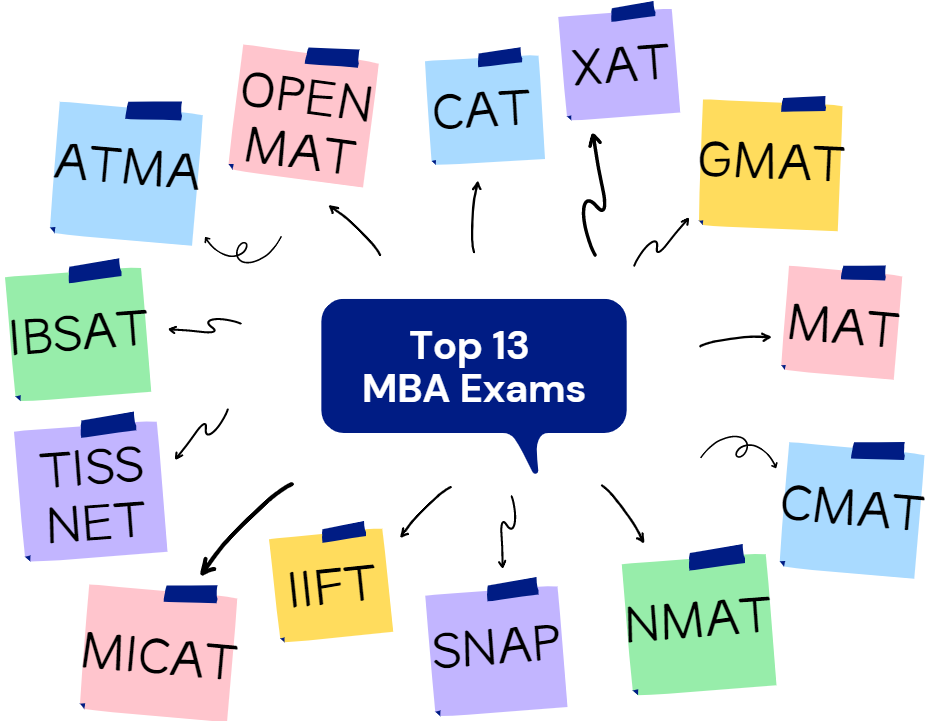
Competencies you Must Have for CAT Exam
Competencies, technically speaking, mean all your Interests, Aptitudes/Abilities, Skills and Personality/ Behavioral Traits put together. It is a sum that can be expressed as:
Interests + Aptitudes/Abilities + Skills + Personality/ Behavioral Traits + Knowledge
Out of these, Knowledge refers to what you gain from your training. In this case, it would essentially point at the knowledge you earn through training during an MBA program. The rest, are typically with you already while you’re reading this! Yes, you will need these before your MBA entrance exam.
We will discuss some common ‘already present’ competencies (interests, abilities & skills in this section; personalities in the next section) for an MBA entrance exam, in a short while.
You must understand that these are the strengths that you will have to start with when you begin your preparation for MBA entrance exams. These are certain inherent attributes that are developed through the years of schooling and cannot be cultivated ad hoc only during the year(s) of your preparation for an MBA entrance exam.
For example, mathematical reasoning questions are not exactly about formulae or equations. You will need at least an average level of aptitudes for such numerical/ analytical approaches to formulate your answers to these questions.
These are qualities that are supposed to be inherent in MBA aspirants like you before your MBA entrance exam and cannot be built as & when required. These are attributed to your “temporal (with time) progression of knowledge” and are part of cognitive development through your childhood.
Communication Skills Needed to Succeed in CAT Exam
Verbal abilities and written skills are way too important to succeed in an MBA Entrance Exam. While you must know that, GDs (Group Discussions), will put your managerial attributes like interpersonal skills, analytical application, rational thinking, leadership skills, and knowledge content to test in CAT Exam.
These will all be evaluated with respect to your communication skills and proficiency in spoken English through these GDs of CAT Exam.
Your written skills, however, are typically tested after you are shortlisted for the final admission round. IIMs and other top B-schools test your writing skills through Written Ability Test (WAT), which is a pen-paper based writing test of 15 to 30 minutes duration in the final rounds.
Here, it is important to note that, out of the 20 IIMs all except 2 have replaced GD round by WAT round as their final selection process for admission to their flagship programs. They have found WAT to be a better testing process to assess a candidate than GD.
This is due to the established fact that many candidates could not express their opinion & views, however logical they may be, during a GD because of many who could speak louder being capable of making their presence felt during the GD round. In WAT, however, a candidate can freely put down her views and thoughts on paper coherently without any fear of getting disrupted.
Whether it is spoken English or written, you must be able to communicate, convey, and corroborate (three C’s) your ideas convincingly.
Also, read: GMAT vs CAT
Industry and Business Knowledge is a Must for CAT Exam
Your knowledge about the top contributing industry verticals and the corporate world as a whole shall be tested in the final rounds of interviews. You must be well-prepped for it.
- You must be aware of some resounding names in the industry, few of the top enterprises and the industry vertical they are operating in as well as about their contributions (why they are famous if they are).
- You must have a sound foundation over ideas about the types of industries existing in the current market scenario (primary, secondary, etc.), their roles in an economy, especially banking or IT industries which have tremendous contributions to market dynamics.
- You must be well equipped with firm knowledge about the best performers in a given industry vertical.
- You must be aware of recent national & international developments or changes that have been introduced in terms of economic policies or in the corporate world by big honchos in an industry vertical.
- Know the latest who’s who, latest government policies affecting the industry altogether etc.
- It is important to be able to recognize the logos of different companies and have an idea of the possible thought behind it.
- Be familiar with abbreviations of business houses, the latest tie-ups of national & international companies, and business achievements above all.
Awareness about Managerial Roles is a Must for CAT Exam
You will be expected to have a fair idea of what you will be entrusted with if you get absorbed into a managerial role. Your knowledge in this area will only be tested in the final rounds of interviews.
Personnel in managerial roles are responsible for planning, directing & overseeing operations, performance or fiscal health of a business unit, division, department, or an operating unit within an organization. The duties & responsibilities associated with a managerial role vary with the kind of business that is being engaged with or with the department that the role is part of.
An MBA degree equips you with the skills to conduct, supervise, and handle people engaged in business & its operations efficiently, any kind of business or a business segment.
You will require a plethora of skills like delegation of responsibilities, emotional intelligence, team management skills, and effectively using business tools & strategies for costing, budgeting, to say the least.
CAT Exam – Useful Links
- Crack MBA entrance exams – 21 things you must know
- CAT information bulletin
- XAT website
- GMAT official portal
- MAT information bulletin
- CMAT Official Portal
- NMAT website
- SNAP website
- IIFT MBA Entrance Exam website
- MICA Selection Process and Timelines
- TISS Website
- ICFAI website
- AIMS Test for Management Admissions (ATMA) – Official Portal and information bulletin
- How to Get Admission in IIM Colleges in India
- How to Prepare for CAT Exam
CAT Exam – Conclusions
Looking forward to getting admission in an esteemed business school after clearing the CAT exam? Hope we’ve been able to help you with all-round knowledge about the CAT exam pattern, the CAT exam syllabus, eligibility for CAT exam as well as tiny other details. Nevertheless, you need handholding to get you through this. How about a discussion with our expert career counselors with decades of experience concerning education in the field of management?

With a Master’s in Biophysics-Biostatistics, Sreenanda acquired professional experience in computational proteomics of human molecules. She is currently working with the Research and Data Team at iDreamCareer.













i like this super post
Very well written post.
Nice post author. Thank you for the nice share. Keep it up.
Thank you so much for your kind appreciation. Keep reading!